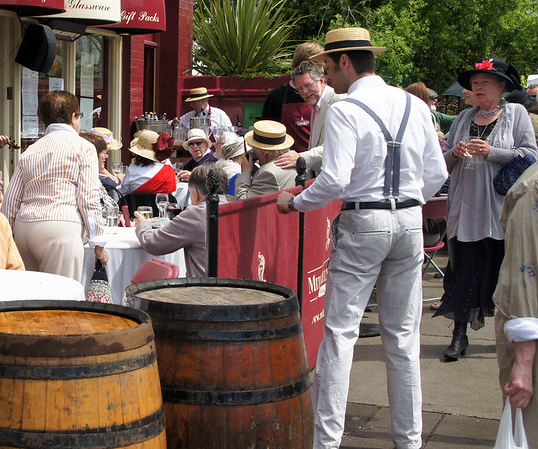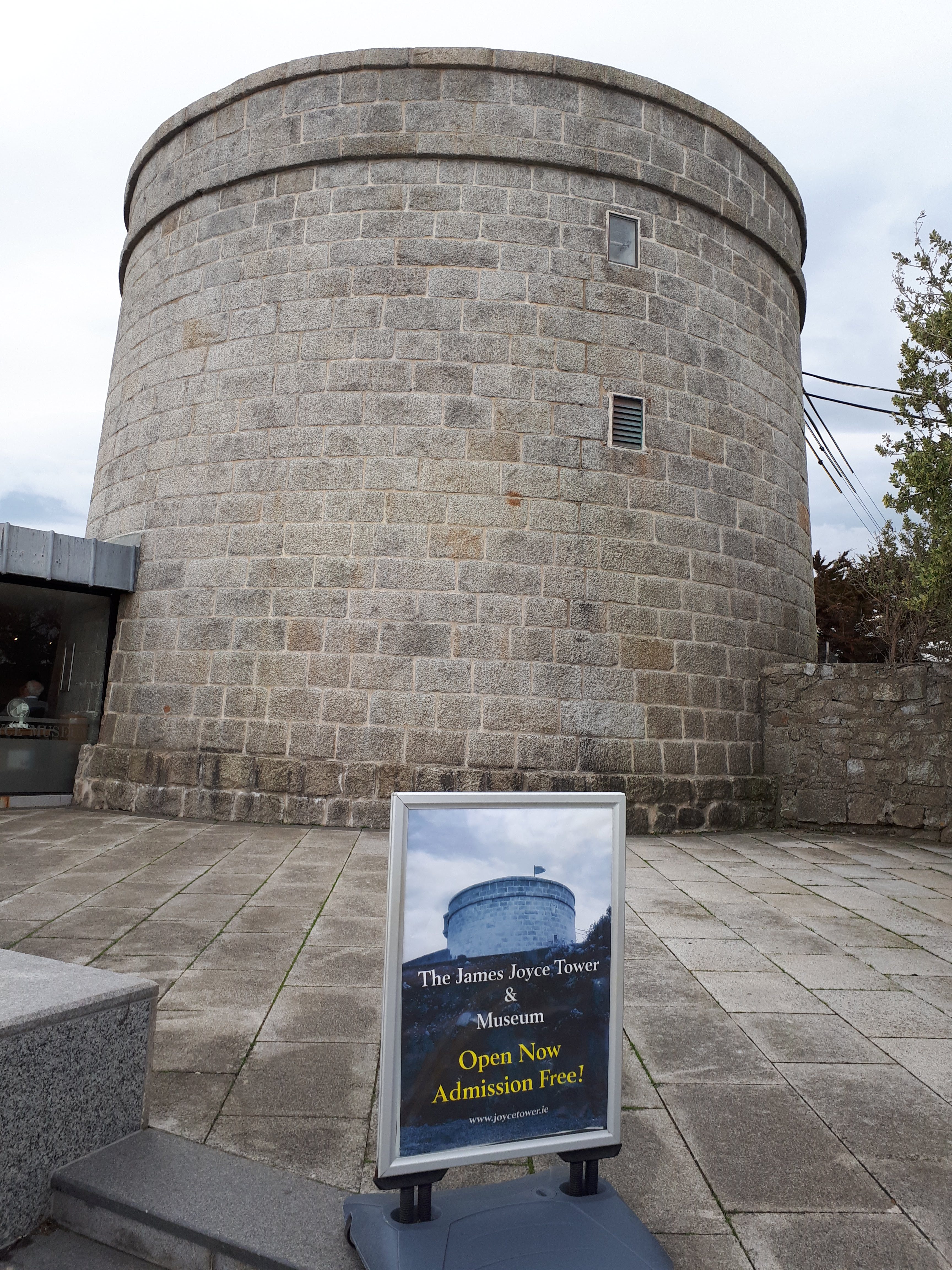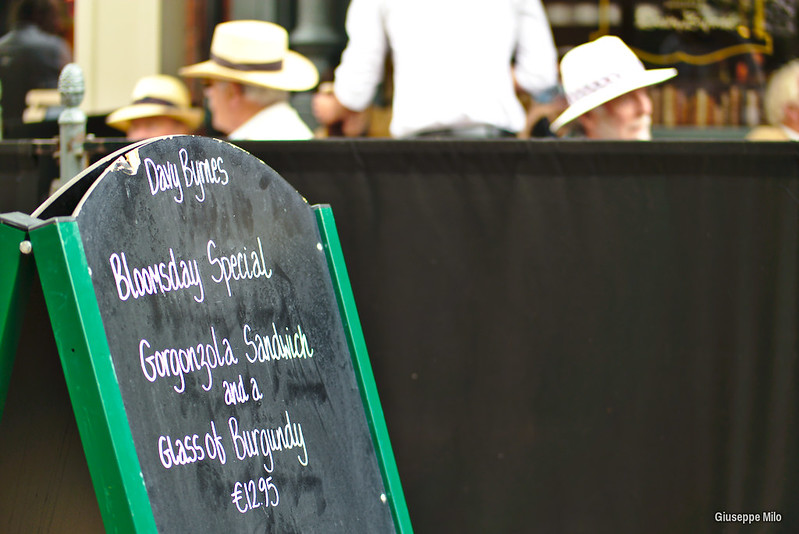Today, June 16th, we Irish remember and celebrate the work of James Joyce, one of the most influential and important authors of the 20th century.
So let’s begin with 10 amazing facts with which you can stun your family and friends – not to mention excelling at your next quiz!!
1. James Augustine Aloysius Joyce was born in Dublin in 1882.
2. He was raised in a middle class Catholic family, the eldest of 12 children.
3. A brilliant linguist (learning Norwegian in order to read Ibsen’s work in its original language!) he studied French at university and adopted Italian as the language of the home with his family. He could speak 17 languages including Irish, German, Greek, Hebrew, Russian, Finnish, Polish, Arabic and Sanskrit!
4. He spent most of his adult life in self-imposed exile (and virtual poverty) in Europe – mainly Trieste, Paris and Zurich.
 (He taught English in Austria-Hungary, now Croatia. Mural, Opatija, Croatia)
(He taught English in Austria-Hungary, now Croatia. Mural, Opatija, Croatia)
5. His muse, and the love of his life, was Galway chambermaid Nora Barnacle whom he married in 1931 after having lived together for 27 years. They had 2 children, Georgio and Lucia. It was a very passionate relationship, with many erotic letters still in existence. She was no great fan of his work however, saying after the publication of Ulysses ‘Why don’t you write sensible books that people can read’
6. He was a man of phobias! He suffered from cynophobia (fear of dogs), having been bitten as a child. His astraphobia (fear of thunder and lightning) began when he was told as a child that thunder was the sound of an angry God. (Once asked by a friend why he was so afraid of bad weather, Joyce replied, ‘You were not brought up in Catholic Ireland’). This fear probably inspired his 100-letter word which represents a thunderclap in his final novel Finnegan’s Wake (1939):
Bababadalgharaghtakamminarronnkonnbronntonnerronntuonnthunntrovarrhounawnskawntoohoohoordenenthurnuk
(The word is actually partly comprised of different words for thunder including French (tonnerre), Italian (tuono), Ancient Greek (bronte) and Japanese (kaminari)).
7. He was plagued with eye problems for most of his adult life. He had about two dozen eye surgeries over the years and often had to wear an eye patch. This forced him to use large sheets of white paper and a red crayon when writing so he could see his work clearly. (His daughter was named after St Lucia – the patron saint of the blind).
8. In the 1960’s, physicist Murray Gell-Mann liked the line ‘Three quarks for Muster Mark’ in Joyce’s novel Finnegans Wake so much, he suggested QUARK as the name for his subatomic particle proposal.
9. Joyce died in Zurich in 1941, at the age of 59, after surgery for a perforated ulcer. His final words are said to have been ‘Does nobody understand?’.
10. In 1999, Time Magazine named him as of the 100 Most Important People of the 20th Century.
Trivia Moment
Joyce met fellow novelist Marcel Proust at a dinner in 1922. Much to the disappointment of the other guests, the two writers spent the meal discussing their ailments, before eventually admitting that they hadn’t read each other’s work. Also on the guest list that night were Picasso and Stravinsky. Joyce and Proust supposedly shared a cab home but Proust scampered without paying his half of the fare!
His Work
As a writer, Joyce’s grasp of philosophy, theology, mythology and foreign languages enabled him to experiment with English language and stretch it to its limits. Although he was to spend most of his adult life in mainland Europe, his novels are set in Dublin and his characters are based on family, Irish friends – and Irish enemies!
His first published book was Chamber Music (1907), a collection of love poems. His best known works include the short-story collection Dubliners (1914) and novels A Portrait of the Artist as a Young Man (1916), Ulysses (1922) and Finnegans Wake (1939). Other writings include books of poetry, a play Exiles (1918), published letters and occasional newspaper articles.
Ullysses
“I’ve put in so many enigmas and puzzles that it will keep the professors busy for centuries arguing over what I meant, and that’s the only way of insuring one’s immortality.” (his reply when asked for a plan of Ulysses)
Considered his greatest work, Joyce began writing Ulysses in 1914. By 1918, it was being serialised in the American magazine Little Review. The novel was published in its entirety in Paris in 1922. An obscenity lawsuit resulted in the book being banned in the United States until 1934. Critics were divided because of its innovative style. Of course such controversies only made the book more successful.
Loosely based on Homer’s Odyssey, Ulysses is an account of a single ordinary day in the life of Leopold Bloom, an advertising salesman living in Dublin in 1904. Each of the 18 chapters corresponds loosely with an episode in the Greek epic.
Bloom, leaving his wife Molly at home in bed, befriends a young artist, Stephen Dedalus. (Bloom is comparable to Odysseus, Molly to Odysseus’ lover Penelope, and Dedalus to Telemachus). As they spend the day wandering through Dublin, their encounters include a funeral (DEATH), a maternity hospital (BIRTH), a brothel (SEX) and a library (ART).
Ulysses has always been considered one of the most difficult books to read in the English language. It is written mostly as a ‘stream of consciousness’ where thoughts, memories and reflections are not bound by the restrictions of traditional sentence structure, punctuation and grammar (Molly’s final monologue has a sentence with 4391 words!!). This experimental form, as well as Joyce’s sexually explicit and blasphemous language, made Ulysses an important milestone in the development of the modern novel.
Bloomsday
The day is named after Leopold Bloom.
Ulysses is set in 16 June 1904 – this was the day on which he and Nora Barnacle had their first date. The character Molly Bloom was actually based on Nora.
We Irish never let a good opportunity go to waste and Bloomsday is now a week long festival of walks and talks, highbrow and lowbrow lectures and readings, music, drink and lots of craic!
Celebrating Bloomsday
*Dressing for the day is very important – the Edwardian fashion of the period, and in particular, the straw boater!
*Visiting the locations where the novel takes place.
 (Traditionally, festivities begin at the Martello Tower in Sandycove, South Dublin, which is where the novel opens).
(Traditionally, festivities begin at the Martello Tower in Sandycove, South Dublin, which is where the novel opens).
*Eating food mentioned in the book. This is a tricky one!
Mr. Leopold Bloom ate with relish the inner organs of beasts and fowls. He liked their giblet soup, nutty gizzards, a stuffed roast heart, liver slices fried with crust crumbs, fried hencod’s roes. Most of all he liked grilled mutton kidneys which gave to his palate a fine tang of scented urine.
Ok – not for everyone – easier to head to Davy Byrnes pub for a gorgonzola sandwich and a glass of burgundy!

*Performing readings from the text.

*For the 100th anniversary in 2004, ten thousand people attended a free open-air traditional Irish breakfast in Dublin. In 2011, there was a world wide tweeting of the entire novel (at about 265,000 words long, that’s some tweeting!!)
*2020 will also be a year to remember – but for a different reason! However, you can all take part in the online programme at Bloomsday Festival
A few quotable quotes..
Shut your eyes and see. (Ulysses)
Love loves to love love. (Ulysses)
A man of genius makes no mistakes. His errors are volitional and are the portals of discovery. (Ulysses)
She respected her husband in the same way as she respected the General Post Office, as something large, secure and fixed. (Dubliners)
Mr. Duffy lived a short distance from his body. (Dubliners)
He wanted to cry quietly but not for himself: for the words, so beautiful and sad, like music (A Portrait of the Artist as a Young Man)
Can’t bring back time. Like holding water in your hand. (Ulysses)
Why is it that words like these seem dull and cold? Is it because there is no word tender enough to be your name? (Dubliners)
Absence, the highest form of presence. (A Portrait of the Artist as a Young Man)
And, in honour of my travel blog, I have to finish with this one…!!!
I wanted real adventure to happen to myself. But real adventures, I reflected, do not happen to people who remain at home: they must be sought abroad.
Happy Bloomsday!
Photo Credit:
Bowler Hat – infomatique on VisualHunt / CC BY-SA
Davy Byrnes – Giuseppe Milo (www.pixael.com) on Visual Hunt / CC BY


So interesting, I’ve heard of James Joyce of course but never read his books. What an amazingly intelligent man
He certainly was. If you ever decide to read anything, I’d suggest beginning with ‘Dubliners’ XXXMarie
Thanks for the recommendation
Of course I have heard of James Joyce, 20 years in Paris! Some of the places he lived I have been by it such as the Hôtel Corneille, 5 rue Corneille ; The Hotel Lutetia & Brasserie, 45 Boulevard Raspail, Victoria Palace Hotel, 6 rue Blaise Desgoffe ; 71 Rue Cardinal Lemoine; and there is even a placename after him ; Square James Joyce, 7 rue George-Balanchine .Cheers
Good for you! I’ve just realised that the post is a bit parochial – Bloomsday is of course celebrated in cities around the world, especially in places with direct associations with Joyce. I’m sure there would usually be events held in Paris – d on’t know about this year though. XXXMarie
yes this year is tough for large events maybe after the rentrée here in september. Cheers
This is such a great post. I love Irish writers and mostly been reading Yeats. Your post reminds me to look into James Joyce too, just have to wait for my local library to finally open, it’s been so long! Did you, Marie, had a chance to see and hear the thunderstorms? It was rather wild here in Sligo and kids were hiding under a duvet 🙈🙈Thanks for sharing and have a good day. Aiva 😊😊😊
I’ve actually prompted myself here to go back to Joyce. I’ve read ‘Dubliners’ a few times and got through ‘Ulysses’ once. I started ‘Portrait….’ and Finnegan’s Wake’ but gave up. Certainly not a light summer read!
No thunderstorms here!!! We’ve been watching the weather warnings of course but they got it right – beaches busy here and bbqs working overtime!! Hope it passes soon….
And a Happy Bloomsday to you too, Marie. I got to Dublin in, I think, ’99 to help some friends celebrate the occasion but I must confess it was mostly eating and drinking – and the craic, of course. Few Joycean epiphanies or even readings but Joyce wouldn’t have expected that as the Irish treated him so shabbily in his writing days, that any acknowledgement would be a bonus so we felt we’d gone some way to making it up to him while enjoying ourselves! Sadly, I never got through Ulysses although I may a few starts at it, loved Portrait of the Artist as a Young Man, and Dubliners of course. I presume you’ve seen the masterly film made from the short story, “The Dead”, in that collection, by John Huston & starring his daughter Angelica Huston? It’s one I can watch many times. You don’t mention Joyce’s poetry which is less well known but is so good. I think he’s only written one short book of poems, Pomes Penyeach. Thanks for this Post. I need reminding of my heritage every so often and you do it so well.
‘The Dead’ is considered one of the best short stories in the English language. The film was wonderful. There’s another collection of poems – Chamber Music. I don’t remember doing any Joyce poetry at school…. Thanks as always for your support. XXXMarie
Wow, I didn’t realise he was quite such a genius, especially as regards languages. As to his writing though… even his readable ‘Dubliners’ I found unremarkable. And I visited the tower in Sandycove once – it was closed 🙁
Oh Dear!!!! I think you should spend the next 12 months swotting up on your Joycean literature – if you work in reverse order you will love Dubliners by the time you get to it!!!! 📚 And then come to Dublin for Bloomsday 2021!! – The Tower will definitely be open! 😅 😂 🤣